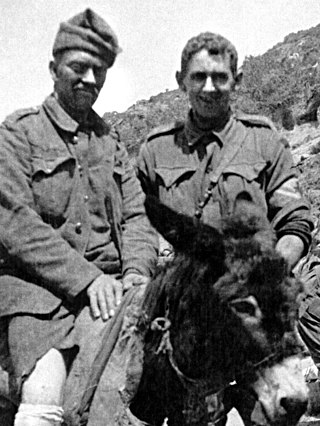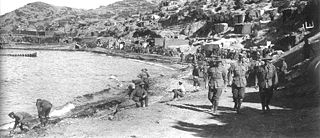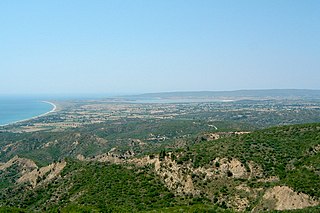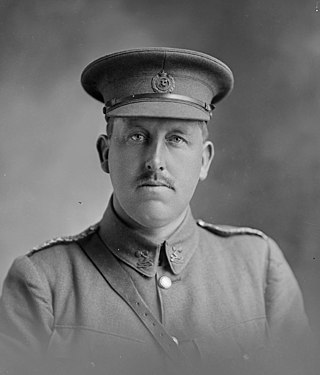
Anzac Day is a national day of remembrance in Australia, New Zealand and Tonga that broadly commemorates all Australians and New Zealanders "who served and died in all wars, conflicts, and peacekeeping operations" and "the contribution and suffering of all those who have served". Observed on 25 April each year, Anzac Day was originally devised to honour the members of the Australian and New Zealand Army Corps (ANZAC) who served in the Gallipoli campaign, their first engagement in the First World War (1914–1918).

The Gallipoli campaign, the Dardanelles campaign, the Defence of Gallipoli or the Battle of Gallipoli was a military campaign in the First World War on the Gallipoli peninsula from 19 February 1915 to 9 January 1916. The Entente powers, Britain, France and the Russian Empire, sought to weaken the Ottoman Empire, one of the Central Powers, by taking control of the Ottoman straits. This would expose the Ottoman capital at Constantinople to bombardment by Entente battleships and cut it off from the Asian part of the empire. With the Ottoman Empire defeated, the Suez Canal would be safe and the Bosphorus and Dardanelles straits would be open to Entente supplies to the Black Sea and warm-water ports in Russia.

The Battle of Lone Pine was fought between Australian and New Zealand Army Corps (ANZAC) and Ottoman Empire forces during the Gallipoli Campaign of the First World War, between 6 and 10 August 1915. The battle was part of a diversionary attack to draw Ottoman attention away from the main assaults being conducted by British, Indian and New Zealand troops around Sari Bair, Chunuk Bair and Hill 971, which became known as the August Offensive.

The Battle of Chunuk Bair was a World War I battle fought between the Ottoman defenders and troops of the British Empire over control of the peak in August 1915. The capture of Chunuk Bair,, the secondary peak of the Sari Bair range, was one of the two objectives of the Battle of Sari Bair.

The landing at Anzac Cove on Sunday, 25 April 1915, also known as the landing at Gaba Tepe and, to the Turks, as the Arıburnu Battle, was part of the amphibious invasion of the Gallipoli Peninsula by the forces of the British Empire, which began the land phase of the Gallipoli campaign of the First World War.

John Kirkpatrick, commonly known as John Simpson, was a stretcher bearer with the 3rd Australian Field Ambulance during the Gallipoli campaign – the Allied attempt to capture Constantinople, capital of the Ottoman Empire, during the First World War.

Anzac Cove is a small cove on the Gallipoli peninsula in Turkey. It became famous as the site of World War I landing of the ANZACs on 25 April 1915. The cove is 600 metres (2,000 ft) long, bounded by the headlands of Arıburnu to the north and Little Arıburnu, known as Hell Spit, to the south. Following the landing at Anzac Cove, the beach became the main base for the Australian and New Zealand troops for the eight months of the Gallipoli campaign.
This article presents the timeline of the Gallipoli Campaign. The period of the proper battle is considered to be 19 February 1915 to 9 January 1916; however, a number of events took place between August 1914 and January 1915 that are relevant to the battle.

The landing at Suvla Bay was an amphibious landing made at Suvla on the Aegean coast of the Gallipoli peninsula in the Ottoman Empire as part of the August Offensive, the final British attempt to break the deadlock of the Battle of Gallipoli. The landing, which commenced on the night of 6 August 1915, was intended to support a breakout from the ANZAC sector, five miles (8 km) to the south.

Cape Helles is the rocky headland at the southwesternmost tip of the Gallipoli peninsula, Turkey. It was the scene of heavy fighting between Ottoman Turkish and British troops during the landing at Cape Helles at the beginning of the Gallipoli campaign in 1915. The name derives from the Greek Helle; Helles means "Helle's" in Greek.

Lieutenant Colonel Arthur Plugge, CMG, was an English-born officer who served during the First World War with the New Zealand Military Forces.

Shrapnel Valley Cemetery is a cemetery from World War I and is the second largest Commonwealth War Graves Commission Cemetery in the former Anzac sector of the Gallipoli Peninsula, Turkey, after Lone Pine Cemetery.

Quinn's Post Cemetery is a Commonwealth War Graves Commission cemetery from World War I in the former Anzac sector of the Gallipoli Peninsula, Turkey. The battles at Gallipoli, some of whose participating soldiers are buried at this cemetery, were an eight-month campaign fought by Commonwealth and French forces against Turkish forces in an attempt to force Turkey out of the war, to relieve the deadlock of the Western Front (France/Belgium) and to open a supply route to Russia through the Dardanelles and the Black Sea.

Plugge's Plateau Cemetery is the smallest Commonwealth War Graves Commission cemetery on the Gallipoli Peninsula in Turkey. It contains some of soldiers killed during World War I during the battles at Gallipoli, was an eight-month campaign fought by Commonwealth and French forces against Turkish forces in an attempt to force Turkey out of the war, to relieve the deadlock of the Western Front (France/Belgium) and to open a supply route to Russia through the Dardanelles and the Black Sea.

Hill 60 Cemetery is a Commonwealth War Graves Commission cemetery dating from World War I at the Northern end of the former Anzac sector of the Gallipoli Peninsula, Turkey and the location of Hill 60 Memorial, one of four memorials on the peninsula which commemorate New Zealanders killed in the campaign but who have no known grave.

Courtney's and Steel's Post Cemetery is a Commonwealth War Graves Commission cemetery located near ANZAC Cove on the Gallipoli peninsula in Turkey. It contains the graves of some of the former British Empire troops who died during the Gallipoli Campaign.

Lone Pine Cemetery is a Commonwealth War Graves Commission cemetery dating from World War I in the former Anzac sector of the Gallipoli Peninsula, Turkey and the location of the Lone Pine Memorial, one of five memorials on the peninsula which commemorate servicemen of the former British Empire killed in the campaign but who have no known grave.

Private Richard Alexander Henderson MM was a school-teacher who served with the New Zealand Medical Corps at the Battle of Gallipoli. Like John Simpson Kirkpatrick, he used a donkey to carry wounded soldiers from the battlefield. He was later honoured with a Military Medal for repeatedly rescuing wounded from the battlefield while under heavy fire at the Battle of the Somme.

The third attack on Anzac Cove was an engagement during the Gallipoli Campaign of the First World War. The attack was conducted by the forces of the Ottoman Turkish Empire, against the forces of the British Empire defending the cove.

The battle for No.3 Post was fought during the Gallipoli Campaign in the First World War, between the forces of the New Zealand Mounted Rifles Brigade and the Turkish 19th Division.



















